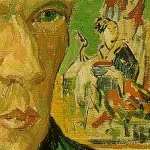Funny thing happened the other day. As part of her anniversary present, my wife gave me a copy of France magazine, a lovely periodical published both in the UK and the US for English-speaking francophiles. Every article and every photograph makes you realize just how badly you want to go back. Later, in bed, I was reading the magazine only to realize that I'd read this issue already. I looked at the cover date: July 2011. She'd accidentally given me a magazine we already owned. We'd re-gifted ourselves! As I looked further into the issue, however, I came across an article I'd somehow missed the first time round: on France's new producers of absinthe. (In 1988, the EU declared legal again the production and consumption of absinthe, after an 80 year ban.) The article explained that today's brands of absinthe, while still around 70 proof, have a much lower wormwood content than the brands produced in the late nineteenth and early twentieth centuries. Wormwood, of course, is the ingredient that it is usually credited for giving absinthe, in its heydey, its famously psychoactive quality. As I wrote in a post many months ago, there is disagreement over the spirit's true psychoactive strength, with some commentators claiming that absinte was, and is, no more potent than any other spirit. Then again, the France article quotes from distiller Dominique Rousselet as he remembers his first drink of absinthe--produced by the traditional method during the years the ban was still in effect. "One
glass--bof!" Rousselet says. "I was reeling, but reeling. [My friend] told me to call home to get someone to collect me, but when I got to the phone I couldn't remember my number. I was too embarrassed to tell him, so I pretended to have a conversation. It was all over the place, my mind. My brain was swimming. . . . I had to confess to my friend that I'd completely forgotten my number. He had the bright idea of using the phone book. I could at least remember my name!"
At the turn of the nineteenth century, "the Green Fairy" was widely seen as a destroyer of men, savager of minds, and killer of families. It was blamed, often with little evidence, for murder, insanity, and a new society of benumbed drunkenness. As I mentioned in my earlier post, part of absinthe's problem was that producers began making inferior but cheaper versions, sometimes--for the sake of holding down cost--substituting for traditional ingredients ingredients that were less expensive but actually proved poisonous. Van Gogh lived in Paris exactly during absinthe's height of popularity, and he befriended exactly the bohemian types of people who adored and popularized the spirit. His name is frequently associated with absinthe. Indeed, the France article only follows this trend. Beneath the article's title runs a subheader: "From Van Gogh to Oscar Wilde, artists and writers have been devotees of absinthe for decades." But there is little actual evidence from Van Gogh's letters that he was an enthusiastic consumer of the spirit. However, the common perception, I think it is fair to say, is that Van Gogh was addicted to the stuff. Problem is, Van Gogh would likely not have been introduced to absinthe until he moved to Paris in the mid-1880s. And the years he lived in Paris he wrote fewer letters than in any other period of his adult life. Thus, there is precious little primary material available from which to draw conclusions. I suspect that the myth--if that's what it is--of Van Gogh's absinthe addiction can be traced to an account, written by Paul Gauguin years after the fact, of their last weeks together in Van Gogh's Yellow House in Arles. Shortly before Van Gogh's infamous December, 1888 breakdown (when he cut off his ear and gave it to a prostitute), Van Gogh and Gauguin took a trip to Montepelier to see the Fabre Museum. What was supposed to be a trip that would renew their friendship turned sour and even turbulent as the housemates argued vociferously over matters of art. According to Gauguin, that night, in an Arles cafe, and without provocation, Van Gogh stood up and tossed a full glass of absinthe in his face. A few days later, the "madman" was cutting his own ear off. The issue here is Gauguin's credibility. Almost none of what Gauguin writes in his account can be verified. It isn't backed up by any other source or any eyewitness account. And all of it--per Gauguin habit--seems designed to make Gauguin come off as brilliantly as possible, and Vincent as badly as possible. (We know, for instance, that following Vincent's death Gauguin told lies about the extent of his artistic influence over Van Gogh, even taking credit for advising Van Gogh during the composition of Sunflowers, despie the fact that the Sunflowers series was completed long before Gauguin even arrived in Arles!)
We'll never know the full truth about Van Gogh and absinthe--or Van Gogh and Gauguin, for that matter--but it's clear that certain myths are bound to remain.














0 comments:
Post a Comment